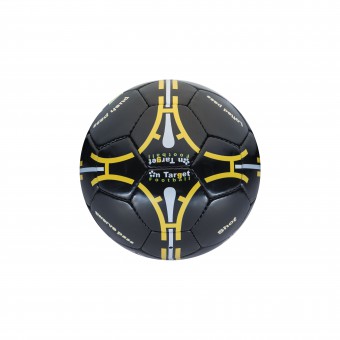On Target Children's football by Jonathan Ashton |
Home > Winners > #59708 |
 |
|
||||
| DESIGN DETAILS | |||||
| DESIGN NAME: On Target PRIMARY FUNCTION: Children's football INSPIRATION: One day, I was looking outside into my local park. I saw children playing football. Some of the children were toe-poking the ball. I thought to myself, wouldn't it be good, if there was a ball, that could help and guide young players. Not all children have access to a coach. Formal coaching only happens when you are part of a club. I researched the market and could not find a ball which had markings on it, that could help players, so I decided to create my own. UNIQUE PROPERTIES / PROJECT DESCRIPTION: The On Target Football is a football, which is unique in that it has instructional markings, that help players visualise where they need to strike the ball to achieve a specific pass or shot. It also helps coaches to help them explain to young children and helping them become better players faster. The On Target Football has 4 sides, each with unique patent-protected markings (USPTO, UK IPO, WIPO, OHIM, Brazil IP and China IP) for each type of pass and shot. OPERATION / FLOW / INTERACTION: Very simple, children can place ball in front of them and place the ball so they can see the markings. It works well when there is a wall as well. A child can practice each shot and pass (4 in total). For a coach it is also useful to help explain to children and telling them how to strike a ball. Push Pass This pass is made with the inside of the foot. The kicking foot is turned outward and the non-kicking foot should be placed to the side of the ball to allow the kicking leg to swing freely. The boot should make contact through the middle of the ball and the ankle must be firm when contact is made. This pass allows the best guarantee of accuracy. Lofted Pass There are three basic techniques for playing passes in the air: the lofted drive, the volley and the chip. If the defence cannot be penetrated on the ground, then the aerial option will need to be used. The symbol on the ball will help you visualise a lofted drive. To loft the ball, contact needs to be made between the lowest part of the ball and the middle. Swerve Pass When attempting a swerve pass, use the outside of the foot across the ball from right to left (for a right-footed kick) or left to right (for a left-footed kick). Contact should be made inside the centre of the ball. The left side for a right-footed kick and the right side for a left-footed kick. One of the advantages of this pass, is that you can bend the ball round an opponent. However the more swerve required, the more difficult it is to make an accurate pass. Shot The symbols on the ball represent laces, to show you where the best contact can be made. There are many different types of shot: high and low shot, swerve shot, volley, and half-volley, shooting with the inside of the foot, flick volleys etc... If you want to achieve a low shot, then you must always lean forward over the ball. Elevated shots on the other hand will require you to lean backwards. However if you lean back too much, the ball may end up in the stands/bushes or worst case scenario someone's window. Contact for a low shot should be towards the middle of the ball and for a high shot, the lower part of the ball must be hit. PROJECT DURATION AND LOCATION: 2 years (2015), Maidenhead, UK. |
PRODUCTION / REALIZATION TECHNOLOGY: I worked closely together with a medium-sized manufacturer in Asia, who was willing to take on this challenge. Many did not want to get involved due to the complexity of production. It is hand-stitched to guarantee quality. SPECIFICATIONS / TECHNICAL PROPERTIES: It is a size 5 football. TAGS: Children, Sports, Football, Soccer RESEARCH ABSTRACT: I researched the football market over a period of months and noticed there was no football like the one I had conceived. Most footballs have a fancy design on them, but they do not add value in any other way. Not for coaches and not for players. When researching the market, I used freely available industry studies available on the internet and some, which were provided by the European Commission and Trade Bodies. CHALLENGE: The hardest challenge was not so much the design part, but finding a ball manufacturer, that could technically achieve this design. There are only a handful of manufactures, that can create this type of football. ADDED DATE: 2017-08-30 20:23:29 TEAM MEMBERS (1) : Jonathan Ashton IMAGE CREDITS: Jonathan Ashton, 2017. PATENTS/COPYRIGHTS: USPTO - Patent approved - US D795,368 S UK IP - Patent approved - 4040829 WIPO - Approved - DM/087 099 OHIM - Approved - 002693366-0001 China IP - Approved - CN 303641458 S Brazil IP - Approved - BR 302015004943-0 |
||||
| Visit the following page to learn more: http://www.ontargetfootball.com | |||||
| CLIENT/STUDIO/BRAND DETAILS | |
 |
NAME: On Target Football PROFILE: - |
| AWARD DETAILS | |
 |
On Target Children's Football by Jonathan Ashton is Winner in Sporting Goods, Fitness and Recreation Equipment Design Category, 2017 - 2018.· Press Members: Login or Register to request an exclusive interview with Jonathan Ashton. · Click here to register inorder to view the profile and other works by Jonathan Ashton. |
| SOCIAL |
| + Add to Likes / Favorites | Send to My Email | Comment | Testimonials | View Press-Release | Press Kit |






